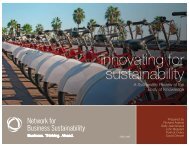embedding sustainability in organizational culture - Network for ...
embedding sustainability in organizational culture - Network for ...
embedding sustainability in organizational culture - Network for ...
You also want an ePaper? Increase the reach of your titles
YUMPU automatically turns print PDFs into web optimized ePapers that Google loves.
Chapter 1: 4: Introduction Clarify<strong>in</strong>g expectations<br />
30<br />
Employees can deliver on <strong>susta<strong>in</strong>ability</strong> objectives more easily if they are built<br />
<strong>in</strong>to daily operations and practices. The development of detailed standards and<br />
procedures clarifies and re<strong>in</strong><strong>for</strong>ces expected behaviours. In short, this practice is<br />
about translat<strong>in</strong>g your ideas <strong>in</strong>to desired actions.<br />
We f<strong>in</strong>d prelim<strong>in</strong>ary support <strong>for</strong> the importance of operationaliz<strong>in</strong>g <strong>in</strong> the research<br />
studies reviewed. Reverdy (2006) found that the translation of environmental<br />
requirements <strong>in</strong>to everyday work practices was necessary <strong>for</strong> the successful<br />
implementation of an environmental management system. Zhao (2004) found<br />
that the lack of ef<strong>for</strong>ts to l<strong>in</strong>k susta<strong>in</strong>able development to daily operations was one<br />
of the ma<strong>in</strong> causes of <strong>in</strong>action and a key h<strong>in</strong>drance to implement<strong>in</strong>g susta<strong>in</strong>able<br />
development.<br />
Both the <strong>in</strong>novation and safety literatures suggest that operationaliz<strong>in</strong>g is an<br />
important practice. Bank of America embedded a <strong>culture</strong> of <strong>in</strong>novation by provid<strong>in</strong>g<br />
explicit guidance on how managers should engage with employees to achieve<br />
the organization’s goals (Beck, 1987). Becker (2008) found that <strong>in</strong>novation was<br />
embedded when behaviour change was mandated through deadl<strong>in</strong>es. Enacted<br />
<strong>for</strong>malized safety policies helped embed a safety <strong>culture</strong> <strong>in</strong> a study by Cox, Jones and<br />
Coll<strong>in</strong>son (2006). They added, however, that the safety <strong>culture</strong> is weakened when<br />
policies are underm<strong>in</strong>ed by a lack of support<strong>in</strong>g management practices and when<br />
punishment rather than rewards are used.<br />
Operationaliz<strong>in</strong>g receives prelim<strong>in</strong>ary support but further research is needed to<br />
understand how best to operationalize <strong>susta<strong>in</strong>ability</strong>.<br />
assessment: Weakly supported<br />
<strong>in</strong>tegrate<br />
Here we explore the <strong>for</strong>mal <strong>in</strong>tegration of <strong>susta<strong>in</strong>ability</strong> <strong>in</strong>to the way the<br />
organization currently operates. This <strong>in</strong>cludes <strong>in</strong>corporat<strong>in</strong>g <strong>susta<strong>in</strong>ability</strong> <strong>in</strong>to<br />
an organization’s mission, vision, and values; strategy; bus<strong>in</strong>ess plans; bus<strong>in</strong>ess<br />
processes; roles; management systems; and product design and life cycle. Through<br />
this <strong>in</strong>tegration, an organization truly commits to cultural trans<strong>for</strong>mation by<br />
<strong>in</strong>corporat<strong>in</strong>g <strong>susta<strong>in</strong>ability</strong> <strong>in</strong>to its core.<br />
<strong>in</strong>tEgRatE <strong>in</strong>to MiSSion, viSion and valuES: <strong>in</strong>corporate <strong>susta<strong>in</strong>ability</strong><br />
values <strong>in</strong>to the organization’s mission, vision and values<br />
• Establish a new mission if one does not exist or if it does not<br />
explicitly address <strong>susta<strong>in</strong>ability</strong><br />
• Update the organization’s vision to reflect what it would be like if it<br />
were truly susta<strong>in</strong>able<br />
• Incorporate <strong>susta<strong>in</strong>ability</strong> <strong>in</strong> the organization’s values<br />
• Increase the level of priority <strong>for</strong> <strong>susta<strong>in</strong>ability</strong> among the<br />
organization’s values<br />
An organization’s mission, vision and values are <strong>for</strong>mal, overarch<strong>in</strong>g statements<br />
of commitment that send a clear message to its employees and other stakeholders<br />
about its position on <strong>susta<strong>in</strong>ability</strong>. Practitioners noted that <strong>in</strong>tegration of<br />
<strong>susta<strong>in</strong>ability</strong> <strong>in</strong>to these elements holds everyone from board members to employees<br />
accountable <strong>for</strong> their actions and encourages employees to take <strong>susta<strong>in</strong>ability</strong> <strong>in</strong>to<br />
account when mak<strong>in</strong>g decisions. Clear articulation of <strong>susta<strong>in</strong>ability</strong> with<strong>in</strong> the<br />
mission, vision, and values may also help to foster alignment <strong>in</strong> an organization<br />
(Strandberg, 2009). By <strong>in</strong>tegrat<strong>in</strong>g <strong>susta<strong>in</strong>ability</strong> <strong>in</strong>to the mission, vision and<br />
values, an organization <strong>in</strong>spires and motivates employees to take obligations to the<br />
next level (Epste<strong>in</strong>, 2008) and enables leadership to challenge their people to do<br />
someth<strong>in</strong>g great (Hart, 2005).<br />
There was only very prelim<strong>in</strong>ary empirical support <strong>for</strong> the value of <strong>in</strong>tegrat<strong>in</strong>g<br />
<strong>susta<strong>in</strong>ability</strong> <strong>in</strong>to missions, visions and values. Harris and Crane (2002) found that<br />
when <strong>susta<strong>in</strong>ability</strong> was <strong>in</strong>tegrated <strong>in</strong>to an organization’s mission statement, its<br />
managers sensed a change toward the support of susta<strong>in</strong>able growth.<br />
In other literature perta<strong>in</strong><strong>in</strong>g to <strong>embedd<strong>in</strong>g</strong> <strong>culture</strong>, Gilbert and Ivancevich (2000)<br />
expla<strong>in</strong> that a diversity <strong>culture</strong> is embedded by mak<strong>in</strong>g diversity part of the<br />
organization’s mission, beyond what is required by regulation. In the <strong>in</strong>novation<br />
literature, Jassawalla and Sashittal (2002) describe that it is through a process<br />
of develop<strong>in</strong>g their own team mission statements <strong>in</strong>corporat<strong>in</strong>g <strong>in</strong>novation that<br />
employees build a sense of collective ownership, commitment, and focus and,<br />
through this, a <strong>culture</strong> of <strong>in</strong>novation.
















